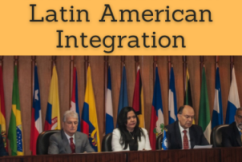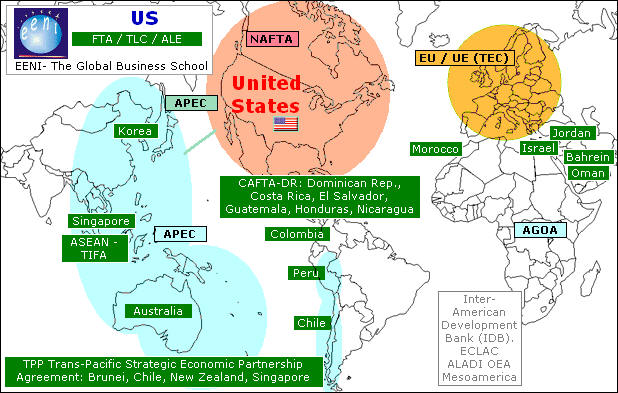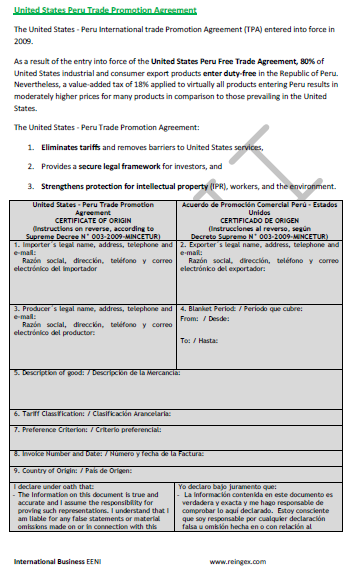Trade Agreements in America (Master)
Module: American Free Trade Agreements - Master / Doctorate (eLearning)



The module “American Free Trade Agreements” belongs to the following Online Programs taught by EENI Global Business School:
Masters: Master in International Business.
Doctorate: American Business, World Trade.
 Master Negocios Internacionales
Master Negocios Internacionales  Master en affaires internationales
Master en affaires internationales  Mestrado em Negócios Internacionais.
Mestrado em Negócios Internacionais.
 Enrol / Request for Information
Enrol / Request for Information
In America there are several Trade Agreements (Free Trade Agreements, Economic Partnership), both regional and extra-regional:
- Intra-regional: USMCA, MERCOSUR, Andean Community, Latin American Integration Association
- Extra-regional: Trans-Pacific Agreement, APEC, agreements with the EU
- Bilateral: U.S. Agreements with Chile, Colombia, Morocco, Australia. Mexico has trade agreements with Chile, Uruguay..
Furthermore, each American country can have Trade Agreements with the third countries. For example, Chile has trade agreements with Panama, China, the U.S., Canada, Mexico, South Korea, Central America, the EFTA, Australia, Peru, and, Turkey.
Chile is a member of the Comprehensive and Progressive Agreement for Trans-Pacific Partnership and the APEC.
A company wishing to do business in America should know all these agreements in force for all the target markets in the region.
If the country of the exporter (or importer):
a) Has agreements in force with an American country:
The exporter should take advantages of the agreement (tariff reductions, rules and certificate of origin, technical standards, FDI, IPR, public procurement, Trade in Services...) however, it also needs to know if other countries may have agreements in force with one of these countries.
b) Has no agreement in force with any America country:
One possible scenario is that another country (or region) can have an agreement in force with the American Countries. Then, the exporter has a disadvantage.
All these factors are essential to design and adapt the International Marketing strategy for each target market in America.
For example, an Argentinian company wishing to export to the U.S. would be at a disadvantage with a Chilean company, as Chile has a free trade agreement in force with the U.S., and the Argentinian company has all the advantages inherent to the agreement. The Argentinian company should consider this factor in its export strategy to the region.
The Master in Business in America includes the following Free Trade Agreements and institutions related to foreign trade in the region.


US-Mexico-Canada Agreement (USMCA/NAFTA 2.0).
United States Free Trade Agreements.
- US-Australia FTA
- US-South Korea FTA
- US-Singapore FTA
- US-Chile FTA
- US-Colombia FTA
- US-Peru FTA
- US-Panama FTA
- US-Central America-Dominican Republic FTA
- US-Bahrain
- US-Oman
- US-Jordan
- US-Morocco
- US-Israel
- EU-U.S.
- ASEAN-U.S.
- Comprehensive and Progressive Agreement for Trans-Pacific Partnership (negotiations)
- AGOA - United States-Africa
Canada.
- Colombia-Canada FTA
- Peru-Canada FTA
- Chile-Canada FTA
- Panama-Canada FTA
- Honduras-Canada FTA
- Canada-Costa Rica FTA
- EFTA-Canada FTA
- ASEAN-Canada FTA
- India-Canada FTA
- Jordan-Canada FTA
- Mexico-Northern Triangle (El Salvador, Guatemala, and Honduras)
- Mexico-Costa Rica FTA
- Mexico-Nicaragua FTA
- Mexico-Colombia FTA
- Mexico-Uruguay
- Mexico-Chile FTA
- Mexico-MERCOSUR
- EU-Mexico
- Mexico-EFTA Agreement
- Mexico-Japan FTA
- Mexico-Israel
Free Trade Agreements in Central America.
- Central America-Chile FTA
- EU-Central America
- Central America-Panama FTA
- Central America-Dominican Republic FTA
- China-Costa Rica FTA
- CARICOM-Costa Rica FTA
- Colombia-Northern Triangle
- Taiwan-Honduras-El Salvador
- Guatemala-Taiwan FTA
- Taiwan-Nicaragua FTA
- Panama-Taiwan FTA
- Singapore-Panama FTA
- Panama-Central America
- Panama-Chile FTA
- Andean Community-Panama FTA
Colombian Free Trade Agreements.
Peruvian Free Trade Agreements.
Agreements of the Andean Community.
- Andean Community-MERCOSUR
- Andean Community-Chile FTA
- Andean Community-India FTA
- Andean Community-China FTA
- EU-Andean Community
- Andean Community-Russia
MERCOSUR Agreements.
Chile's Agreements.

(c) EENI Global Business School (1995-2024)
We do not use cookies
Top of this page



